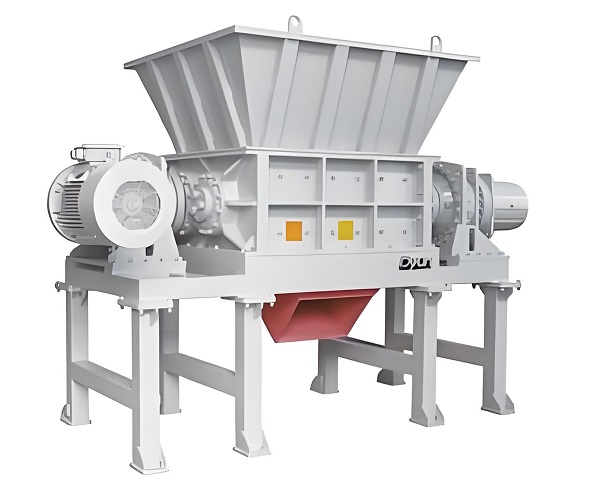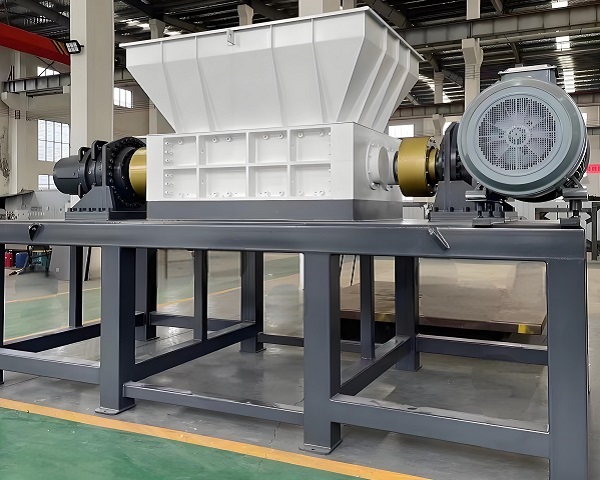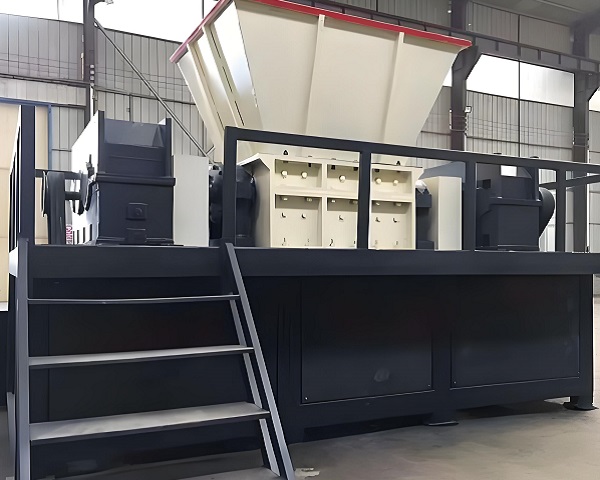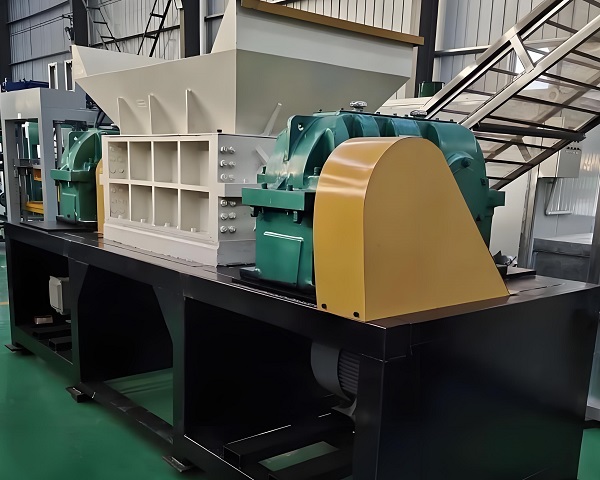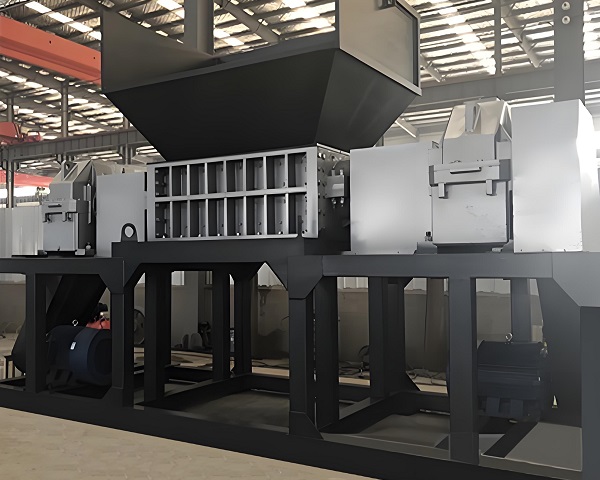A Trommel Screen is a rotary drum screening machine widely used in waste processing, mining, and construction industries. It efficiently separates materials by ......
What is the Pre-Shredder
Pre-Shredder is a high-efficiency crushing equipment specially used for pre-processing of large wastes, usually used in the front-end link of solid waste treatment line. Its main function is to preliminarily shear and loosen the original large, high-strength and complex-structured waste, reduce the material size and break the accumulation state, so that the subsequent fine crushing equipment (such as double-shaft shredder, single-shaft shredder, etc.) can operate stably and efficiently. Pre-Shredder has strong feeding capacity, good adaptability and low operating cost, and is one of the key equipment in modern solid waste resource treatment system.
In terms of structural design, pre-shredder generally adopts low-speed and high-torque drive mode to ensure that the equipment has sufficient cutting force and impact resistance when facing high-hardness and high-density materials. Its knife shaft is generally a single-shaft or double-shaft structure, with replaceable knives and wear-resistant liners, so that the equipment has excellent adaptability and reliability when processing metals, vehicle shells, refrigerator shells, electrical appliance shells, packaging waste, coils and other materials. Some advanced models also have functions such as automatic reversal, hydraulic forced feeding, and anti-winding to ensure continuous work without interruption and improve overall processing capacity.
In terms of automation and intelligence, Pre-Shredder is usually equipped with a PLC control system, which can realize automatic start and stop, load monitoring, abnormal alarm and remote control, effectively reduce manual intervention, and improve the safety and stability of equipment operation. The discharge size of the equipment is generally 100mm\~300mm, which is convenient for forming an efficient linkage with the back-end equipment, effectively improving the production capacity and energy efficiency of the entire processing system.
Pre-shredders also perform well in reducing operating costs. Through the intervention of the pretreatment link, the failure rate of the back-end equipment can be reduced, the maintenance frequency can be reduced, and the tool life can be extended. At the same time, a more uniform crushing particle size distribution can be achieved, providing a better raw material basis for the subsequent sorting, packaging, smelting and other links of the material. In general, Pre-Shredder is a modern equipment that combines high-strength mechanical properties and intelligent control technology. It is an indispensable and important equipment for achieving efficient, environmentally friendly and safe production in the waste resource recycling industry.
Operating principle of Pre-Shredder
The working principle of Pre-Shredder is mainly based on the principle of mechanical shearing and tearing at low speed and high torque, combined with hydraulic drive or motor drive system, to preliminarily crush and loosen large-volume, complex structure or solid waste that is difficult to crush directly. Its core is to disassemble the original material into medium-sized fragments through the coordinated shearing, tearing and squeezing of multiple knife shafts, laying a good foundation for the subsequent fine crushing link.
In actual operation, the pre-shredder first puts large waste into the feed port by a feeding device (such as a grab, conveyor or forklift). There are one or two low-speed rotating spindles inside the equipment, and multiple high-strength wear-resistant knives are equipped on the shaft. These knives are arranged at a specific angle. When the spindle starts to rotate slowly, the knives contact the material and gradually crush the material through multiple actions such as tearing, cutting, and twisting. Unlike high-speed crushing equipment, Pre-Shredder emphasizes "strong low-speed shearing" to ensure that the vibration and noise generated during the processing are small, avoid sparks and secondary damage, and are suitable for processing flammable or high-impact hazardous materials.
Some high-end pre-shredders are equipped with hydraulic propulsion devices to assist in feeding and ensure that the material is evenly compressed in the crushing chamber, thereby improving crushing efficiency and preventing idling. At the same time, many devices have intelligent identification and reversal functions. When encountering oversized blocks or foreign objects stuck, the system will automatically reverse for a few seconds to release pressure and then continue to work forward to prevent damage to the knife shaft or equipment shutdown. In addition, pre-screening or magnetic separation devices can be configured to initially separate iron metal or excessive debris in the pretreatment stage to improve the operating efficiency of the overall crushing system.
The crushed material is discharged through the discharge port, and its size is usually controlled between 100-300mm, which is convenient for subsequent equipment processing and can reduce energy consumption and equipment wear. The whole process is carried out in a closed space and can be equipped with a dust removal system to meet environmental emission requirements. In summary, Pre-Shredder realizes safe, efficient and low-energy pretreatment of large and complex solid waste through its stable low-speed shearing principle and intelligent control system, and is an indispensable key equipment in modern waste treatment processes.
Advantages and features of Pre-Shredder
As a key equipment in the material pre-processing link, the pre-shredder plays an important role in many industries, and its advantages and characteristics are significant, as follows:
1. Efficient crushing, improving the efficiency of subsequent processing
The pre-shredder has a strong crushing capacity and can quickly crush large-sized and irregular materials into smaller pieces. Taking the treatment of waste furniture as an example, the untreated furniture is large in size, and directly entering the subsequent processing equipment will lead to low processing efficiency, and may even cause equipment jamming and damage. The pre-shredder can first break the furniture into pieces of appropriate size, providing a more suitable material size for subsequent crushing, sorting and other processes, greatly shortening the overall processing time and improving the efficiency of the entire production process.
2. Strong adaptability, processing a variety of materials
It has a wide range of adaptability to materials, whether it is hard wood, metal scraps, or plastics and rubbers with a certain degree of flexibility, it can be effectively crushed. In the field of resource recycling, the waste composition of different sources is complex. With its excellent adaptability, the pre-shredder can easily cope with various mixed materials, without the need to strictly classify the materials, reducing the pre-processing cost and work difficulty.
3. Strong structure, stable and reliable operation
The pre-shredder uses high-strength materials and advanced manufacturing technology to ensure that the equipment remains stable and reliable under long-term high-load operation. The key components such as the knife shaft and blade have been specially treated to have high wear resistance and impact resistance, and can withstand the huge pressure and friction generated during the material crushing process. At the same time, the equipment is equipped with a complete overload protection device. When encountering unbreakable hard objects or too much material, it can automatically stop for protection to avoid equipment damage and extend the service life of the equipment.
4. Easy operation and low maintenance cost
The operating interface design of the pre-shredder is simple and easy to understand, and the operator can get started after simple training. In terms of daily maintenance, the structural layout of the equipment is reasonable, which is convenient for cleaning the internal residual materials and checking the operating status of each component. Maintenance operations such as blade replacement are also relatively simple, reducing maintenance costs and time costs. In addition, its energy consumption is low, while ensuring the crushing effect, it saves energy expenses for the enterprise.
Technical Parameter Table of Pre-Shredder
| Model | Number of Shafts | Motor Power (kW) | Shaft Speed (rpm) | Capacity (t/h) | Max Input Size (mm) | Output Size (mm) | Blade Material | Dimensions (mm) | Weight (t) |
|---|---|---|---|---|---|---|---|---|---|
| PS-800 | 1 | 75 | 10–20 | 5–8 | ≤1000 | 100–300 | 9CrSi / CrMoV | 2800 × 1800 × 2300 | 8 |
| PS-1000 | 1 | 90 | 10–18 | 8–12 | ≤1200 | 100–300 | 9CrSi / H13 | 3200 × 2000 × 2400 | 10 |
| PS-1200 | 2 | 2 × 75 | 8–15 | 12–18 | ≤1500 | 100–250 | Cr12MoV / D2 | 3600 × 2200 × 2600 | 13 |
| PS-1500 | 2 | 2 × 90 | 8–12 | 15–25 | ≤1800 | 100–200 | Cr12MoV / D2 | 4200 × 2500 × 2800 | 16 |
| PS-1800 Heavy | 2 | 2 × 110 | 6–10 | 20–35 | ≤2000 | 100–200 | Cr12MoV / SKD-11 | 4800 × 2800 × 3000 | 20 |
| PS-2000 Industrial | 2 | 2 × 132 | 6–10 | 30–50 | ≤2200 | 80–150 | SKD-11 / Customized | 5200 × 3000 × 3200 | 25 |
If you have any special requirements, we will customize according to your special needs.
Product Picture Display of Pre-Shredder
FAQ about Pre-Shredder
>What is a pre-shredder?
A pre-shredder is a device used for the preliminary crushing of materials. Its main function is to decompose large-volume, irregular-shaped materials into smaller sizes for further processing by the subsequent main crushing equipment. It is often used in the material pretreatment process in the fields of solid waste treatment and resource recycling, which can reduce the load of the main equipment and improve the overall production efficiency.
>What is the working principle of a pre-shredder?
pre-shredders usually adopt a multi-axis or dual-axis design. Through the interlocking of staggered knife groups, the materials entering the crushing chamber are torn, sheared and squeezed. The motor drives the knife shaft to rotate at a low speed, and the high torque characteristics are used to gradually decompose the materials. The preliminarily crushed materials are discharged from the screen to prepare for the subsequent fine crushing process.
>What are the characteristics of a pre-shredder?
The pre-shredder has the operating characteristics of high torque and low speed, and can effectively handle high-toughness and large-volume materials; the modular knife design facilitates quick replacement and maintenance; it is equipped with an intelligent overload protection system, which automatically stops or reverses when encountering hard objects; it can be linked with the main shredder, conveyor and other equipment to realize the integration of automated production lines and improve processing efficiency.
>What materials are suitable for pre-shredders?
It is suitable for processing large-sized materials such as waste furniture, large plastic pipes, bundled metal waste, industrial scraps, etc. It is also often used for preliminary crushing before sorting domestic waste, as well as the pre-treatment stage of dismantling waste tires and electronic waste, converting them into small pieces of materials suitable for subsequent deep processing.
>What is the processing efficiency of the pre-shredder?
The processing efficiency depends on the equipment model and material characteristics. Small pre-shredders can process 1-3 tons of materials per hour, which is suitable for small recycling stations; large industrial-grade equipment can process up to 5-10 tons per hour, which can meet the pre-treatment needs of large-scale solid waste treatment centers and greatly shorten the overall material processing time.
>Is the pre-shredder energy consumption high?
Compared with fine crushing equipment, the pre-shredder has a larger power, but because it uses a low-speed operation and an efficient transmission system, the energy consumption is at a reasonable level. It reduces the energy consumption per unit processing volume by reducing the impact force required for a single crushing of the material, and the optimized motor configuration can further improve the energy saving effect.
>How to maintain the pre-shredder?
Daily maintenance requires regular inspection of the wear of the cutter, cleaning of residual materials in the crushing chamber to prevent blockage; lubrication and maintenance of bearings and transmission parts; replacement of lubricating oil every 2-4 months according to the frequency of use; if the cutter is notched or deformed, it needs to be repaired or replaced in time to ensure stable operation of the equipment.
>How to control the discharge particle size of the pre-shredder?
The discharge particle size can be controlled by adjusting the aperture size of the bottom screen. Different specifications of screens can achieve different sizes of initial crushing effects. In addition, the speed of the cutter shaft can be adjusted or the arrangement of the cutter can be changed to further optimize the degree of material crushing and meet the feeding requirements of subsequent processes.
>In which industries are pre-shredders used?
It is widely used in solid waste treatment industry (such as material pretreatment in waste incineration plants), resource recycling industry (preliminary disassembly of scrap metals and plastics), wood processing industry (coarse crushing of logs), as well as automobile disassembly, papermaking and other fields. It is an important pre-equipment for building an automated crushing production line.
>What is the future development trend of pre-shredders?
In the future, pre-shredders will develop in the direction of intelligence and multi-function. Intelligence is reflected in the integrated AI recognition system, which automatically determines the material type and adjusts the crushing parameters; multi-function is achieved through modular design, which enables different tool combinations to match diverse materials; at the same time, it strengthens the integration with environmental protection equipment to reduce dust and noise pollution in the pre-processing stage.


























